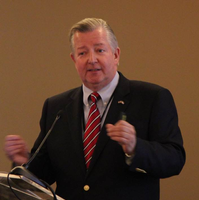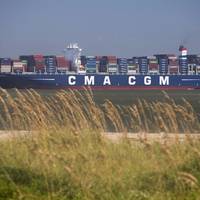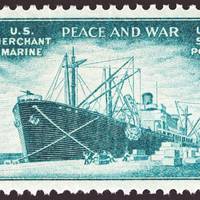Adams Appointed as Managing Director of V.Ships

V.Group has appointed John Adams as managing director of V.Ships UK Ltd. Adams brings a wealth of experience from 30 years at Teekay Shipping, most recently holding the position of Managing Director, Glasgow and Chair of the Operational Leadership Team.In his time at Teekay, Adams played a key leadership role during Teekay’s growth, integrating acquisitions into the expanding fleet operations. He is also Chairman of Bahamas Shipowners’ Association and Vice Chair at the International Chamber of Shipping…
ICS Thrusts on CO2 Reduction
International Chamber of Shipping (ICS) plans to take concrete steps to support further CO2 reduction by international shipping.The representatives of the world’s national shipowners’ associations met last week in the Faroe Islands to review the priorities of the global shipowners’ association.ICS agreed a suite of actions in support of the UN International Maritime Organization (IMO) strategy to decarbonise international shipping in line with the United Nations 1.5 degree climate change goal.Speaking from the Faroe Islands, ICS Chairman, Esben Poulsson said: "It is imperative that IMO Member States adopt a new global regulation to mandate further short term CO2 reduction measures at the next session of the Marine Environment Protection Committee in 2020.
Largest Ship to Visit US East Coast Calls Savannah

The largest containership ever to serve the U.S. East Coast, the 14,414 TEU CMA CGM Theodore Roosevelt, called the Port of Savannah on Friday. Working the vessel with seven cranes at the 1,200-acre Garden City Terminal, the Port of Savannah is expected to move 4,500 containers (approximately 8,000 TEUs) on and off the ship. The GPA will work six other vessels simultaneous to the Roosevelt. “Not only do these massive ships play to Savannah's strengths, they actually make us more efficient,” said Georgia Ports Authority Executive Director Griff Lynch.
Last Port of Call for the U.S. Merchant Marine?
Part II in a two-part series, continued from the January 2017 edition of Maritime Reporter & Engineering News. Read Part I here. If reliance on the foreign commercial market is risky because of uncertain reliability, then what of U.S. Government ownership of a fleet of vessels? That has also been on the menu since the early 20th century. President Woodrow Wilson proposed in September 1914 that the U.S. Government acquire commercial cargo vessels. Congress disagreed, which delayed enactment of the President’s proposal until the Shipping Act, 1916. A compromise was struck to permit U.S. Government ownership as a war time measure – but all vessels so acquired had to be sold to private owners within five years of the end of the war.
Last Port of Call for the US Merchant Marine?

The privately owned U.S.-flag foreign trading fleet, which is an essential component of U.S. sealift capability, stands on the edge of a precipice. The fleet – roughly stable in terms of cargo carrying capacity from 2000 to 2012 – has declined from 106 vessels in 2012 to 78 vessels at October 30, 2016 primarily because of a substantial decline in available U.S. Government-reserved cargo. The size of the fleet has reached a point where the viability of the U.S.-flag industry involved in foreign trade – including its trained mariners…
ICS Conference to Focus on Shipping Agenda
The International Chamber of Shipping (ICS) will focus clearly on its core agenda this year, with experts from key areas of industry across the board speaking at its 2016 International Shipping Conference, to be held at the British Library on Wednesday 7 September. Principal speakers include Kitak Lim, Secretary-General, IMO; Ian Parry, Principal Environmental Fiscal Policy Expert, International Monetary Fund (IMF); and Esben Poulsson, new Chairman of ICS. Reducing CO2 emissions is high on the list of priorities for the industry, and this is reflected in the programme, with an ‘all parties’ session on the issue, chaired by John Adams…
This Day In Naval History: July 11

1798 - President John Adams signs an act that reestablishes the Marine Corps under the Constitution. The following day, Maj. William W. Burrows is appointed Commandant of the Marine Corps. 1918 - Henry Ford launches the first of the 100 intended Eagle boats. These boats have a solid cement bow, especially built for ramming and sinking submarines. Note, production is halted after (PE 60), though some of the boats continue to serve as training and transport vessels until 1947. 1943 - Gunfire from U.S.
Boatbuilding: Portsmouth Naval Shipyard Streamlines Operations With Flexible Buildings
Portsmouth Naval Shipyard (PNS), harbored on an island between Kittery, Maine and Portsmouth, New Hampshire, has weathered many a storm since its creation in 1800 under President John Adams. As the nation's first naval shipyard, PNS has risen and fallen with the fortunes of sail, steam, and atomic-powered seacraft. In recent decades, it has reinvented itself as a top-notch provider in the life cycle maintenance of modern Navy submarines. Yet like other shipyards nationwide, PNS has been under pressure to streamline operations and maximize productivity. To this end, the shipyard has been upgrading its facilities. As buildings for storage…
Birth of the U.S. Navy
By RP3 Bryan J. The U.S. Navy was born on 13 October 1775 by an act of the Continental Congress. Long-building political tensions between the British Empire and its American colonies had broken out into armed conflict. Peace and reconciliation efforts were failing. If the colonies were going to win their independence, they would need a Navy. 1775 was a tumultuous year for the British Empire and its American colonies. Political conflict became military conflict in April when colonists and British soldiers clashed at the Massachusetts towns of Lexington and Concord. Two months later, colonists and British soldiers clashed again; this time they fought on the outskirts of Boston on Bunker Hill with far greater casualties.





